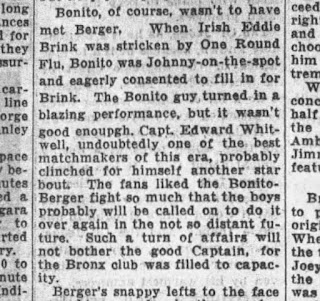From World War I Bombing Runs to NYC Boxing Matches: the Life of Edward Whitwell
Edward Horton Whitwell: 1879-1942 (Husband of Second Cousin 2x Removed)
Edward
Horton Whitwell landed in my family tree when he married opera star Florence
Macbeth, my second-cousin 2x removed. He deserved a post of his own, however
brief, due to his amazing career change following his marriage. Captain
Whitwell was an RAF pilot in World War I, became a military recruiter of sorts
for the British Empire, and then turned to promoting boxing matches at the New
York City Coliseum. From wings to welterweights, from flying to fighters:
Edward Whitwell led an interesting life.
Edward
Horton Whitwell was born May 29, 1879 in Kendal, England. His parents, Isaac
Whitwell and Hannah Martindale Whitwell, had eight other children; Edward was
the fourth oldest.
Edward
appears on the 1881 census as a one-year-old; his father was a bootmaker. By
the 1901 census, Edward is living on his own as a boarder while working as a
plumber and gasfitter.
As World War
I began, Edward apparently joined one of the precursors to the RAF—the RAF didn’t
really become a separate service branch until April 1918, and was built from
the merger of the Royal Flying Corps and the Royal Naval Air Service. The only
record of Edward’s service I have found so far is a card from the “UK WWI Pension
Ledgers and Index Cards, 1914-1923” database, which merely confirms his ranks
as Flight Lieutenant and then Captain in the Air Force.
He seems
to have been older than the average World War I pilot—he was thirty-five when
the war began. All I know of his flying career is a paragraph in a 1918
newspaper article in the Brooklyn Eagle describing an event called Allies Day
the Brooklyn NY YMCA:
“…Captain Edward
Whitwell of the Royal Air Forces of Great Britain, who represented the British
Government (at the event). Captain Whitwell, who has seen three years of
service, gave thrilling accounts of several battles in which he took part. He
told of the tricks used by aviators to get the enemy into a tight corner and
for extricating themselves if they are caught in the same positions. He also
described bombing raids and dangerous photographic work.”
From this
account, it appears that Edward had served as a pilot from 1914-1917, and flew a
variety of missions from reconnaissance to attacks and dogfights.
So how did he end up in the United States giving lectures to the public? Edward apparently was sent by the RAF to the New York area to serve a recruiting function as part of a program called the British-Canadian Recruiting Mission (BCRM).
The program
targeted British and Canadian citizens living and working in the United States,
encouraging them to enlist in British or Canadian units. The Mission handled
all the transportation and visa details. The program was apparently
surprisingly successful, recruiting 33,000 volunteers, most in 1918 when Edward
was part of the effort. One article states that Edward was the aide to Brigadier
General Kenyon, the British head of the BCRM.
 |
| British Canadian Recruiting Mission poster--1918 |
Edward’s
name appears in various articles in newspapers in the New York City area as the
organizer of various military pageants and events. He arranged for opera singer
Florence Macbeth to perform at one of these events, and the two fell in love.
They married after the war on December 8, 1922. He was forty-three years old,
and Florence was thirty-three.
Edward
remained in the United States following his marriage. While he occasionally
travelled with Florence (see the article below mentioning them attending a
dinner in Florence’s honor in California), he spent much of his time in New
York City, where he became involved in the professional boxing world.
He became the boxing impresario for the New York City Coliseum, arranging bouts. In the article below, he is referred to as a "matchmaker"-- quite the clever pun to reflect his role in pairing up boxers for a match.
I have
no idea if he had any previous boxing experience or if he was just a fan of the
sport and used the organizational skills he developed in the BCRM to begin planning
boxing cards and schedules.
In his late fifties, Edward suffered a severe stroke that left his health impaired. He and Florence moved to California. He died there at age sixty-two on April 12, 1942. He was buried in Florence's hometown of Mankato, Minnesota.
 |
| Photo from Findagrave, by RB Hall-Gallea and MS Gallea. |
Sources:
“Allies
Day at YMCA.” Brooklyn Eagle. Brooklyn, New York. Aug. 19, 1918.
Accessed on Newspapers.com on August 30, 2024.
https://en.wikipedia.org/wiki/Royal_Air_Force
Richard
Holt "British Blood Calls British Blood: The British-Canadian Recruiting
Mission of 1917-1918." Canadian Military History 22, 1 (2013) https://scholars.wlu.ca/cgi/viewcontent.cgi?referer=&httpsredir=1&article=1679&context=cmh
Edward
Whitwell headstone. Photo provided by: RB Hall-Gallea & MS Gallea on Findagrave.com
Ad for
Patriotic Rally. New York Tribune. NY, NY. Aug. 14, 1918. Accessed on
Newspapers.com on Aug. 30, 2024.
Society
News: Macbeth feted at reception. Oakland Tribune. Oakland, CA. Oct. 3, 1926.
Accessed on Newspapers.com on Aug. 30, 2024.
Photo of
Edward Whitwell. New York Daily News. NY NY. Jun. 16, 1933.







No comments:
Post a Comment